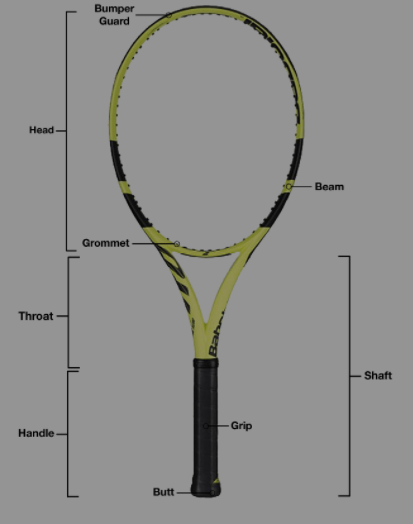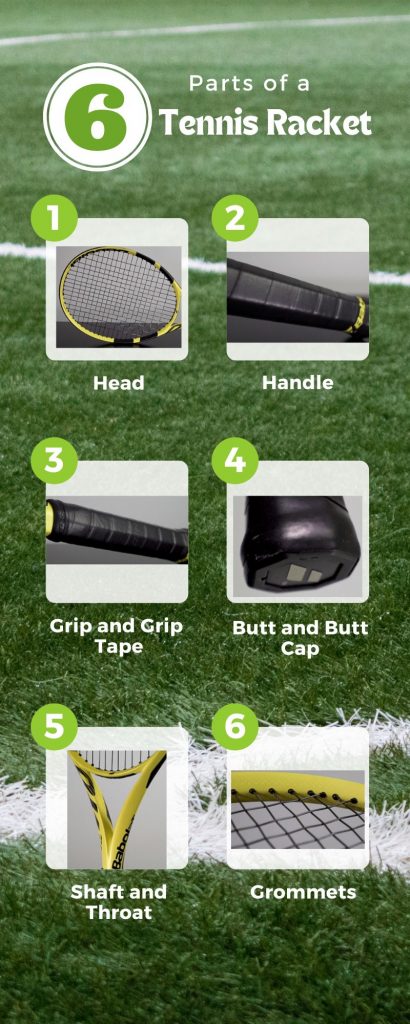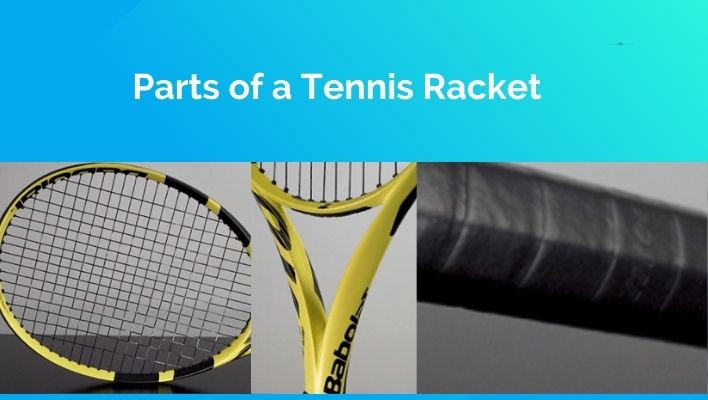For beginners, it’s essential to know about the parts of a tennis racket. To truly be good at a sport, you need to understand every aspect. When it comes to tennis, it’s most important to select the right racquet. It can also be tremendously important to understand each part and how it impacts the performance of your racquet.
If you’re planning to learn tennis, it’s recommended to have a thorough knowledge of the parts of a tennis racket. It’ll help you when your teammates or coaches point to a part of the racquet, you’ll have a clear understanding, and you can speak confidently about any part of a tennis racquet without any confusion.
Before we discuss what are the parts of a racket in detail let’s have a look at the diagram of a tennis racket.

Tennis Racket Parts Name
Let’s break down parts of a tennis racket into three sections:
Handle
- Butt
- Butt Cap
- Grip
- Grip Tape
- Bevels
Shaft
- Throat
Head
- Beam
- Strings
- Grommets
- Bumper Guard
Tennis Racquet Parts
Let’s dig in each part of a tennis racquet one by one.
1. Handle
The handle is one of the most crucial parts of a tennis racquet. It’s the whole length of the area where the player holds the racquet.
Racquets with longer handles provide more power and leverage to the players. The lengths of the racquet handle range from 4 inches to 4 5/8 inches. It’s essential to choose the right tennis handle size to secure grip. With an accurate length of the handle, the chances of exertion decrease.
2. Grip
The grip is the part of a tennis racquet that supports the player’s hand. The material used on the handle not only helps the player’s hand to have comfort and strong grip, and its material not only absorbs the sweat but also prevents the racquet from slipping.
Our guide about how to choose a tennis racket grip size can help you choose the perfect grip size.
3. Grip Tape
The tape at the top of the racquet’s handle secures the grip with the handle.
4. Bevel
A racquet’s handle has eight bevels which not only help the players to grip the handle in the right way but also it prevents twisting in a player’s hand.
5. Butt
Another part of the tennis racquet which may seem small but plays an important role is Butt Cap. It’s the piece of plastic at the end of the racquet. Its outer edge provides support to the player’s hand while hitting.
6. Butt Cap
The butt cap is a plastic cap at the bottom of the racquet’s handle that increases the size of the racquet. It helps the players to have a firm hold on the racquet handle. Some tennis racket butt caps are removable. Manufacturers print their logo on it.
7. Shaft
The shaft is the portion between the handle and the head. It starts from the top of the handle and divides into two sections connecting to the head of the racquet.
Older racquets were different, and they have closed throats, but modern racquets have open throats that help generate more power when hitting.
8. Throat
The throat starts at the top of the handle and ends at the head’s start. Modern racquets have open throats that split into two parts that connect the handle to the head of the racquet. The triangle-shaped open throat helps the air pass through it when the player swings the racket, and it allows the player to swing the racquet more flexibly but with extra power for hitting.
9. Head
The head is in an oval-shaped portion in which strings are installed that are used for hitting. Mostly racquets have different head sizes depending on the size of the entire racquet. However, most head sizes fall between 95 to 110 square inches. If you’re new to tennis, it’s advisable to choose a racquet with a bigger head which prevents the chances of errors.
Generally, the size of a racquet directly affects the player’s performance. For example, a racquet with a larger head will give the player more power over his opponent.
10. Beam
People often ask, what’s the beam of a tennis racket? The beam is the part of the tennis racquet that refers to its side. Some racquets have thicker beams while some have thinner, which depends on the type of racquet player chooses.
Many players overlook this part of the tennis racquet, but there is a massive difference between a racquet with a thicker beam and a thinner one. Power racquets have a wider beam which helps the strings create more power during hitting. In comparison, control racquets have a less thick beam which makes them more flexible and better in control.
11. Grommets
Do tennis racquets have grommets? Yes, they have. One of the parts of tennis racquets is grommets which are the little plastic holes around the inner side of the head’s frame. Grommets prevent the strings from rubbing against the frame, protecting the frame and string passing through it. It also helps the string from breaking.
Small racquets require a smaller grommet and the bigger racquet requires a bigger and wider grommet. Therefore, the dimensions of grommets play a vital role in the performance of the players. A narrow grommet affects the movement, which reduces the power but increases the efficiency of the shot. But a wider grommet increases the chances of a more powerful shot.
12. Bumper Guard
It’s the top part of the tennis racquet. The tennis racket bumper guard protects the strings and its head from scratches. Moreover, the racquet has chances of getting damaged during the game, so the bummer guard plays its role and protects the surface of the head.
Also, if damaged, you can replace the bumper guard, and your racquet will be good as new again.
13. Strings
Strings are the most crucial part of the racket, but they form the face of the head when woven. These are thin materials running throughout the head. The vertical strings are considered mains, while those running horizontally are crosses. Tennis strings are significant because of the contact point with the ball.
Different kinds of strings and the amount of tension they provide affect the feel of the racket and the performance. A tighter string tension of 70 pounds or above provides greater control but requires more power generation. On the other hand, the strings below a tension of 65 can help generate more power, but control of the ball is lost. So, moderate string tension can help achieve the perfect balance of power and control in shots.
You can read our review guide about best tennis strings and best tennis racquet so that you can purchase the best equipment for playing tennis.

Frequently Asked Questions
How many parts of a racket are there?
As mentioned earlier, the tennis racket has 13 parts. But it has three main parts: handle, shaft, and head. These three main parts further contain 10 parts, and we have covered them in detail.
What part of the racquet holds the strings in place?
The Head is responsible for holding strings in place. It can be oval or more rounded, but it creates the primary hitting surface.
What’s the top part of a tennis racquet called?
The racquet is composed of the head, throat, and handle. And the top part of the racket’s head is called the tip.
Final Words
Now, you understand different parts of a tennis racket and how they play their role. Next time when you’ll play tennis, you’ll enjoy this game. If you still have any confusion or query about tennis racquet parts, you can ask in the comment section.






